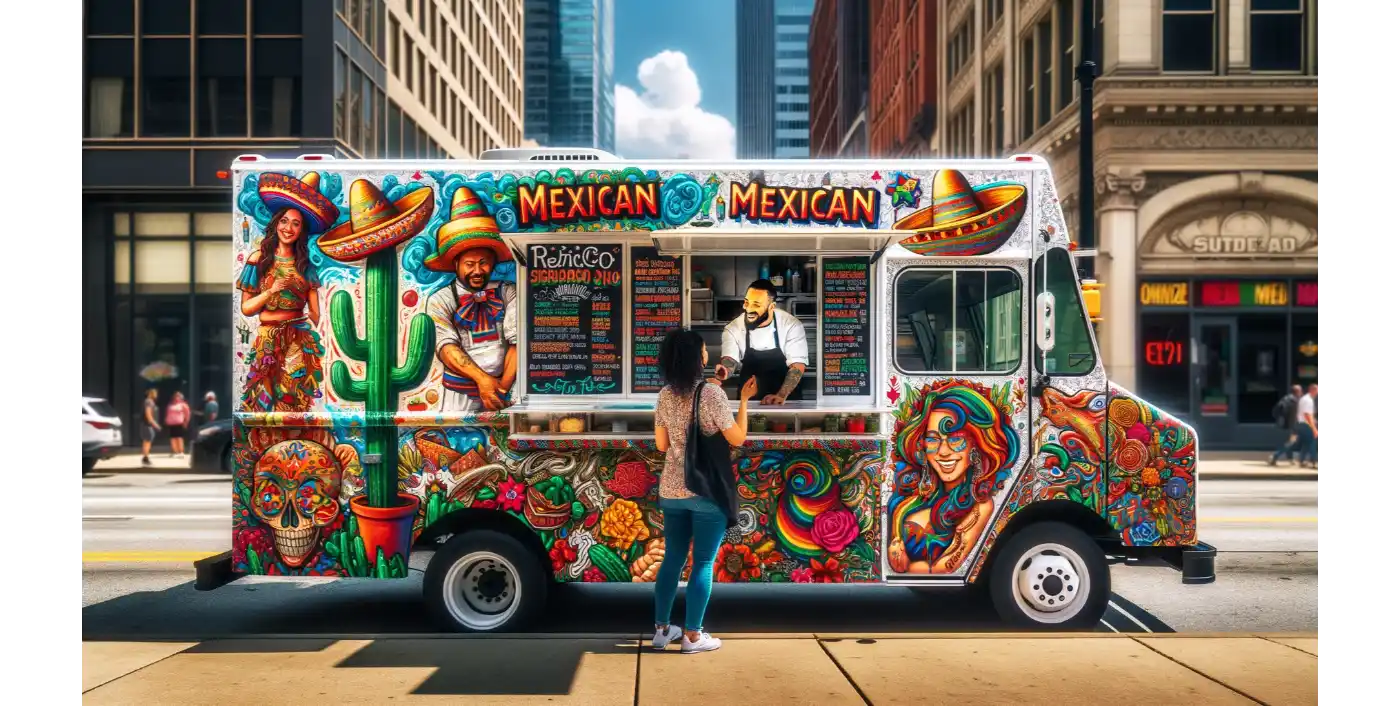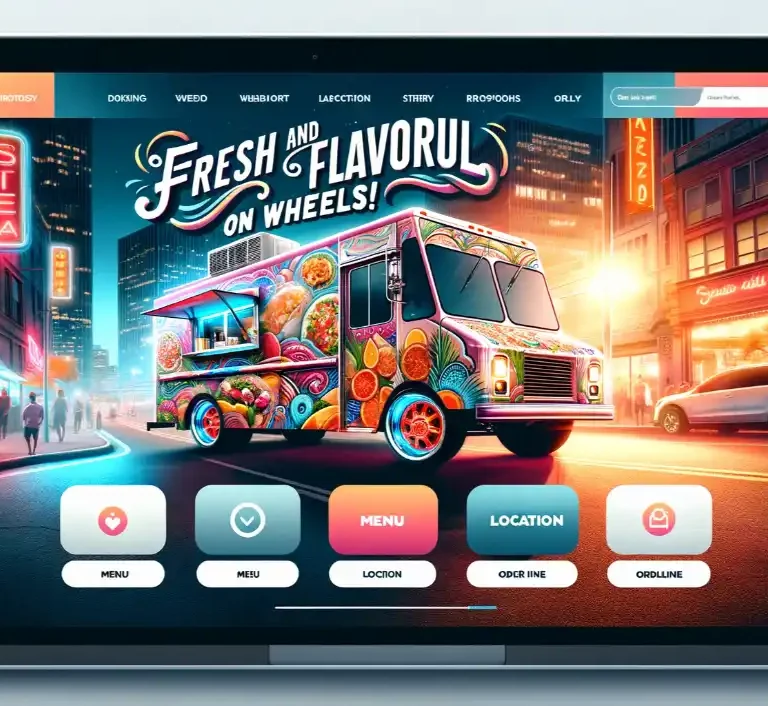Food Truck Branding: Creating A Unique Identity
Food truck branding is more than just a catchy name and a colorful logo.
It’s about creating a unique identity for your mobile food business that embodies your cuisine, concept, values, and target market.
With the U.S. food truck industry boasting an impressive annual revenue of $2.7 billion and a year-on-year growth rate of 9.9% from 2018 to 2023, it’s clear that there’s a significant appetite for this dining trend.
But how can you ensure your food truck stands out in this bustling market, estimated to be worth $1.48 billion by 2023, up from $1.11 billion in 2020?
Why Does Food Truck Branding Matter?
Food truck branding is the vehicle (pun intended) that drives your business toward success. It’s what sets you apart from the 36,324 other food truck businesses in the U.S., and it’s what resonates with the 43% of adults aged 25-44 who account for the lion’s share of food truck spending. Here’s why it’s important:
- Differentiation: Your brand is what sets you apart from the competition. Whether it’s your unique menu, eye-catching truck design, or compelling story, your brand is your ticket to standing out.
- Connection: A strong brand communicates your truck’s story, mission, and message to potential and existing customers. This connection fosters loyalty and repeat business, essential for fueling your success.
- Consistency: Whether it’s your logo, menu, packaging, website, or even the design of your truck, a consistent brand image is key to looking professional and staying top of mind.
- Experience: Your brand is more than just visuals—it’s the overall customer experience. From the moment they see your truck to the time they take their first bite, a memorable experience is what gets customers coming back for more.
Food Truck Branding Success Stories
Let’s look at some food truck brands that have mastered these principles. Kogi BBQ, The Grilled Cheese Truck, and Cousins Maine Lobster are all prime examples of food trucks that have leveraged their branding to create a buzz and carve out a niche for themselves in this competitive market.
Kogi BBQ has become synonymous with Korean-Mexican fusion cuisine, attracting a loyal following with its unique culinary offerings and distinctive truck design. The Grilled Cheese Truck, with its simple yet appealing concept and playful branding, has become a staple at food truck gatherings.
Cousins Maine Lobster, featured on the TV show “Shark Tank,” has leveraged its story and high-quality seafood offerings to build a successful brand and franchise.
Crafting a Winning Food Truck Branding Strategy
In the bustling world of mobile cuisine, branding your food truck effectively is as crucial as the delectable dishes you serve. This guide will walk you through the steps to create a branding strategy that resonates with your audience and sets you apart in the food truck industry.
Step 1: Conduct Market Research and Analysis
Before you set your wheels in motion, it’s essential to understand your local food truck scene. Use online platforms like Food Truckr or Roaming Hunger to identify what’s popular in your area. What are the successful food trucks doing right? Dive into their branding strategies and take notes.
Also, create customer personas to understand your ideal patrons better. Are they office workers looking for quick lunch options or festival-goers seeking exotic foods? Use surveys, polls, or interviews to gather their feedback. Follow industry trends through blogs and podcasts to stay updated with the latest practices.
Step 2: Develop a Brand Identity and Personality
Your food truck’s brand identity is its soul. It’s reflected in your cuisine, concept, vision, and values. Use a brand identity framework to define these core elements. Then, discover your food truck’s personality.
Is it friendly, quirky, or sophisticated?
There are brand personality generators online that can give you inspiration based on your concept and target market.
Step 3: Choose a Catchy and Memorable Food Truck Name
Your food truck’s name is the first impression customers will have of your business. It needs to be catchy and memorable, conveying your brand identity. Brainstorm a list of names that relate to your cuisine, concept, or style. Use wordplay or humor to make your name stand out. Consider using a food truck name generator for inspiration.
Remember to check the name’s availability and legality in your state and local area.
Step 4: Design a Logo and Color Palette
Your logo and color palette are the visual expressions of your brand. They should represent your food truck’s name, cuisine, and concept. Choose a logo style that suits your personality and a color palette that evokes the right emotions. You can use a logo maker or graphic designer to create your logo, and a color palette generator or color wheel to choose your colors.
Step 5: Create a Tagline and Slogan
Your tagline or slogan summarizes your unique selling proposition. It should be short, catchy, and describe what your food truck offers and what makes it different. Use a tagline or slogan generator for ideas and inspiration. Test your tagline or slogan with your potential customers and get their feedback.
Step 6: Craft a Brand Voice and Tone
Your brand voice and tone should match your food truck’s personality and effectively communicate with your customers. Define your voice attributes and tone variations. Use a brand voice and tone chart to create your guidelines and examples. A brand voice and tone analyzer can help maintain consistency and quality.
Step 7: Build a Brand Story and Narrative
Finally, craft a compelling brand story that tells your food truck’s origin, mission, and message. Use a brand story framework to structure your story and a brand story generator for ideas and inspiration. Write it clearly and engagingly using a brand story template.
Remember, your food truck’s branding strategy will be the roadmap guiding all your marketing efforts. So, take the time to do it right. With a solid branding strategy, you’re not just selling food; you’re creating an experience that will keep your customers coming back for more.
Now, are you ready to roll?
How to Implement Your Food Truck Branding Strategy
Creating a Stir with Your Food Truck Design
As a food truck owner, your mobile kitchen itself is a moving advertisement. So, start stirring curiosity with a design that turns heads. Your exterior design is the first impression you make, so make it count. Inject your brand’s personality through a compelling color palette, distinctive logo, and eye-catching graphics that reflect your food concept.
Remember, your food truck’s design is not just about aesthetics; it’s about practicality. Consider the size, shape, and layout of your truck and how your design elements will affect visibility and durability. Will your logo be readable from a distance? Can your graphics withstand various weather conditions? These are questions worth pondering.
Crafting a Menu That Tells Your Story
One of the best “food truck branding ideas” is to create a menu that’s consistent with your brand identity. Just like your truck design, your menu should reflect your brand’s personality, whether it’s quirky, elegant, or anything in between. Use your logo, color palette, and fonts to create a menu that’s not just a list of dishes, but a visual representation of your brand.
As with truck design, practicality matters here too. Think about the size, shape, and format of your menu, and how your customers will interact with it. Is it easy to read? Is it well-organized? These considerations can make the difference between a menu that’s merely functional and one that’s truly memorable.
Packaging that Pops
Every detail counts in branding, and your packaging is no exception. Custom packaging, napkins, cups, utensils, and stickers with your logo and slogan can significantly enhance brand recognition and customer experience. Consider the size, shape, and material of your packaging, prioritizing functionality, sustainability, and hygiene.
Establishing Your Digital Footprint
Your online presence is crucial for credibility and customer engagement. Create a website and social media profiles that use your logo, slogan, and brand story to showcase your food truck’s cuisine, concept, and value. Consider the design, content, and functionality of your website. As for social media, think about the platforms you’ll use, who your audience is, and how often you’ll post.
Promotion Through Marketing Materials
You’ve got your brand identity nailed down on your truck, your menu, and your packaging. Now it’s time to spread the word. Generate leads and sales by creating and distributing marketing materials like flyers, business cards, coupons, and loyalty cards. These should feature your logo, name, slogan, and contact information. When it comes to distribution, consider the location, timing, and method that will reach your target audience most effectively.
Building Relationships Through Engagement
Finally, remember that your brand is not just about visuals and content; it’s about relationships. Engage with your customers and fans on social media, via email, and through online reviews. Use your brand voice and tone to address feedback, answer questions, and address concerns. This engagement will help build customer loyalty and further strengthen your brand.
As a creative branding professional, I understand that food truck branding is a complex task that requires careful thought and planning. However, if done correctly, it can significantly contribute to your food truck’s success. So start brainstorming, planning, and implementing your branding strategy today. Remember, your brand is your promise to your customer, so make it a good one.
Measuring Your Food Truck Branding Success
First things first, you need to establish a baseline. How is your food truck branding performing right now? Use Key Performance Indicators (KPIs) like sales, traffic, conversions, retention, referrals, and reviews as your compass. Tools like Google Analytics, Facebook Insights, and Yelp Dashboard are your best friends here. Compare your results with your set goals and industry benchmarks. This will help you identify your current strengths and weaknesses.
Gathering and Analyzing Customer Feedback
Next, you need to know what your customers think about your brand. Are they loving your food truck park design? Are they raving about your catchy food truck name? Use surveys, polls, interviews, and online reviews to collect this valuable feedback. Tools like SurveyMonkey, Typeform, and Trustpilot can make this process easy and effective. Remember, every piece of feedback is a clue to areas of improvement as well as customer satisfaction and dissatisfaction.
Conducting a SWOT Analysis
A SWOT analysis is a powerful tool to evaluate your food truck’s Strengths, Weaknesses, Opportunities, and Threats. How does your food truck stand against competitors? Does your branding resonate with the current industry trends? Tools like the SWOT Analysis Tool can help you conduct this analysis, revealing your competitive advantages and potential risks.
Refining Your Food Truck Branding Strategy
Once you have all this insight, it’s time to refine your food truck branding strategy. Make changes based on your findings, implement them, and monitor the results. This process is not a one-time thing, but a cycle. Keep repeating this evaluation and improvement process regularly to ensure your strategy stays relevant and effective.
Seeking Professional Help
If the task seems overwhelming, don’t hesitate to seek professional help. Branding experts, designers, and consultants can provide valuable assistance. Online platforms like Fiverr, Upwork, and 99designs can help you find qualified professionals within your budget. Remember, it’s your food truck, make sure your branding goals and expectations are clearly communicated and you’re part of the branding journey.
Wrapping Up
Branding is a crucial part of your food truck business that can’t be overlooked. A compelling brand can help your food truck stand out in the crowd, create a memorable customer experience, and ultimately drive sales. Now that you’re equipped with these insights and recommendations, it’s time to roll up your sleeves and get your food truck branding in motion!
Have any food truck branding ideas or experiences you’d like to share? Feel free to drop them in the comments section or share them on social media. Let’s learn and grow together in this exciting food truck journey!







